Description, operating principle, fuel
What is a biofireplace?
A biofireplace is a modern and safe interpretation of a fireplace without a chimney, which can be used in almost any room, which is undoubtedly an advantage.
How does it work? A biofireplace runs on biofuel, which consists of biological raw materials, and the combustion products are no more harmful than those of a paraffin candle. Externally, a bio-fireplace can resemble a classic version or be a modern design that will decorate a fashionable interior.
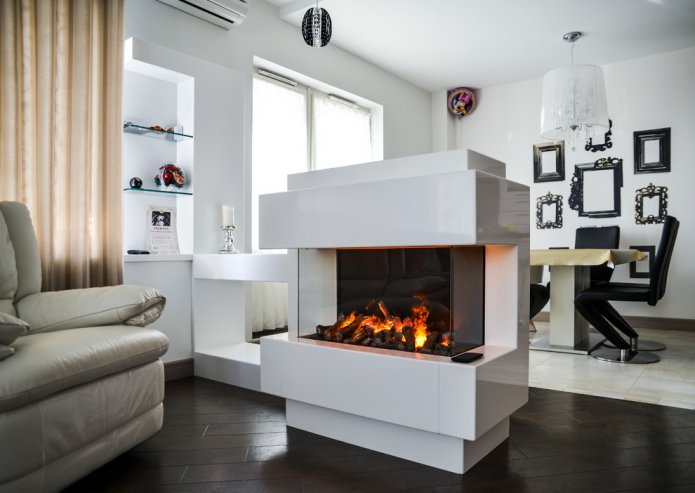
The photo shows a stylish living room combined with a dining area. A two-sided fireplace not only performs a decorative function, but also helps to zone the space of the apartment.
Principle of operation
The principle of operation is quite simple. Fuel is poured into the fuel tank and ignited with a lighter. These two actions are quite enough to get a fire. Ceramic wool is used for safety and slow evaporation of fuel.
Fuel for a bio-fireplace
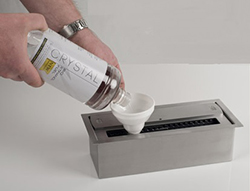

The fuel is technical alcohol. The consistency can be different, for example, gel or liquid. To obtain biogel, alcohol, water, thickener and salt are added to the composition. The liquid form of fuel is obtained by processing agricultural crops.
Fuel consumption is quite economical, on average it is 0.5 liters per hour and a half of operation. But consumption may vary depending on the features of the selected model. The combustion temperature of the flame itself depends on the selected fuel, on average it is 400-600 degrees.
Does the biofireplace heat, heat output
Biofireplaces, in addition to aesthetic pleasure, also give heat. Heat output varies between models, starting from 1 kW and can reach 10 kW. In terms of heat production, a biofireplace can be compared to an electric heater. Small fireplaces most often do not have a heating function.
Do you need an outlet?
There is no need for electricity to operate. Natural flame is formed during the combustion of fuel.
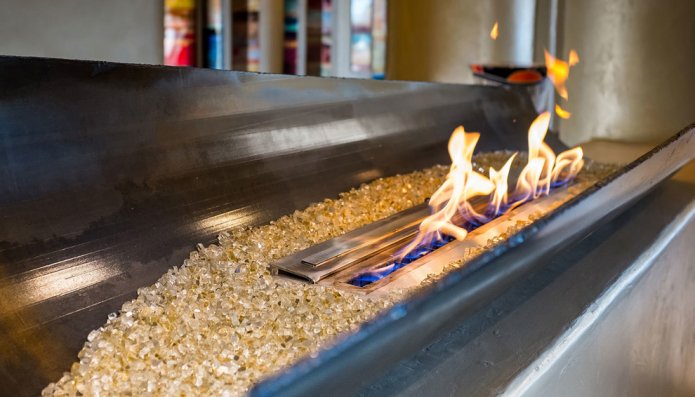
Requirements for the room in which the bio fireplace is installed
The bio fireplace does not have any special requirements for placement, but basic safety precautions must still be observed.
- The room in which the bio fireplace is installed must be well ventilated, but not have strong drafts, as well as fans and air conditioners.
- The distance from any interior items must be at least a meter, and from easily flammable objects, such as paper or textiles, at least one and a half meters.
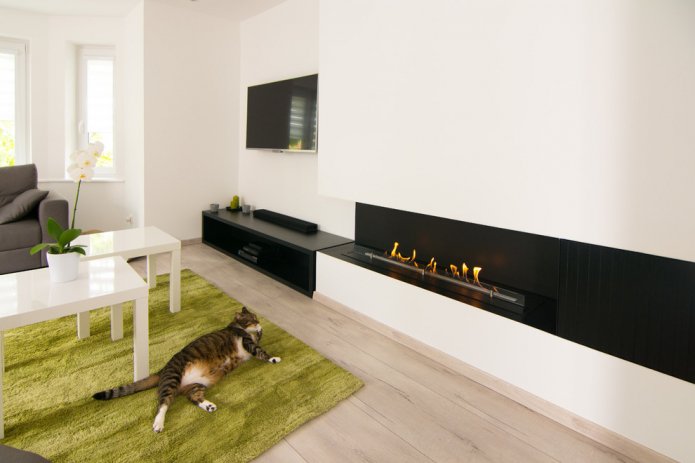
The photo shows a minimalist living room with black and white finishing and a long bio-fireplace.
Traditional, automatic and semi-automatic
The difference between a traditional, automatic and semi-automatic bio-fireplace is in the control technology.
- A traditional, or in other words, mechanical fireplace is lit manually, using matches or a lighter.
- An automatic fireplace is controlled remotely by a phone, tablet or remote control.
- A semi-automatic model starts and ends its work after a command is given through the control panel located on the fireplace.
Open and closed
The difference between the open and closed types is in the design of the fuel tank. The open type allows you to see the amount of liquid inside, while the closed type “hides” the firebox inside the box of the structure.
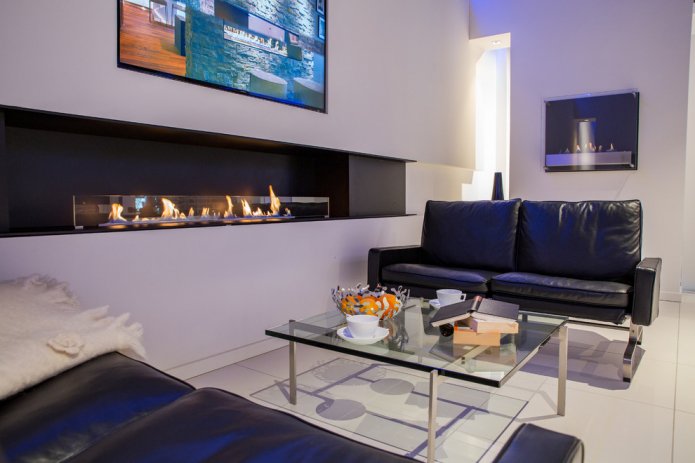
Design
How is the fireplace designed? The design of the body can be almost anything, depending on personal preferences. The main requirement is compliance with safety regulations, or rather the required minimum distance from the flame. The top of the flame should be at least 80 cm from the surface of the body, and the distance to the side should be at least 20-25 cm.

Types and diagrams of burner arrangement
As for the description of burners, they can be of several types and have different characteristics, but they all operate on a common principle, atmospheric evaporation. That is, the fuel evaporates in the chamber under heating in the absence of air, and the vapors released into the atmosphere burn in the air.
There are three types of burners for this operating principle:
- capillary,
- wick,
- gravity.
The capillary burner has a simple design, but there are a number of disadvantages. When starting, you can smell ethanol, the filler of the burner container gets clogged over time and requires replacement, and it is also necessary to provide a shutter and adjust the flame height, since at the beginning of operation the fire burns brighter.
The wick burner is easier to use. Filling the container with fuel is done “by eye”. The flame of this type of burner is stable, without sharp changes, so a screen is not required, except for various flame effects, but it is worth providing a grate-diffuser.
A gravity burner forms a stable flame during operation, does not emit vapors during heating, since their supply is formed in the evaporator and this is enough for starting. In addition, this type of burners can be produced in a round shape, provides long operation, up to 4 hours, and is also suitable for a fireplace of any power.
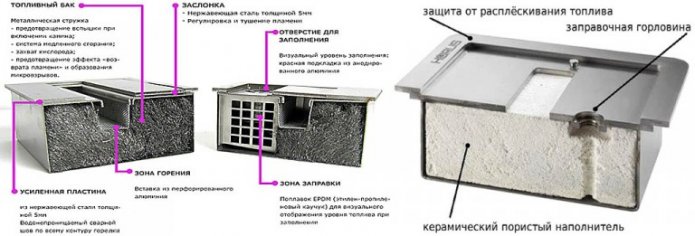
Advantages and disadvantages
A biofireplace, like any other device, has its advantages and disadvantages. It is worth noting the most significant of them.
Pros:
- A bio-fireplace is easy to install and operate;
- In addition to its decorative function in the interior, a bio-fireplace is an additional source of heat;
- Economical fuel consumption and its low cost;
- A wide selection of models;
- Combustion products are not harmful to health.
Cons:
- High cost, especially for models with automatic control;
- Open fire requires careful handling.
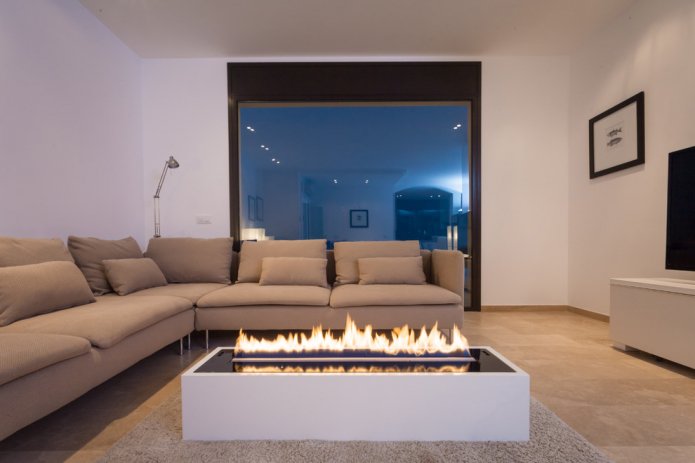
The photo shows a spacious living room in high-tech style. A freestanding floor fireplace replaces a coffee table, and the flame can be seen from anywhere in the room.
Types
Tabletop (portable)
A mobile design that can be easily moved to another room. Such a model produces a minimum of heat and has more of a decorative function in the interior of the room. Mini bio-fireplaces operate on replaceable cartridges.
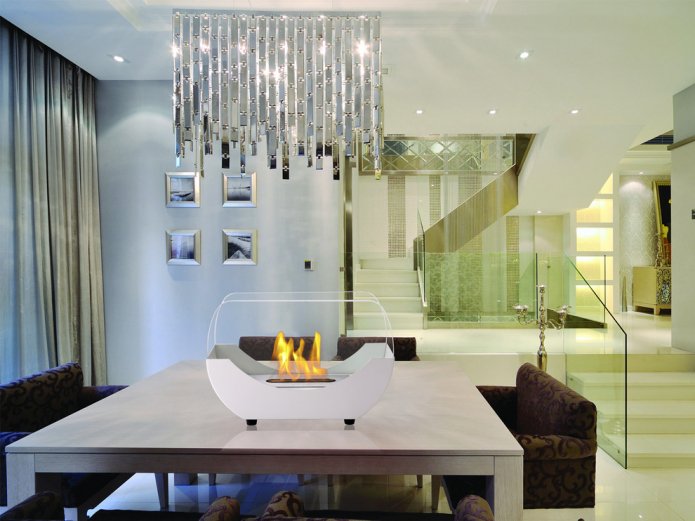
Built-in niche in the wall
An interesting model can be built into one or two vertical planes, i.e. a corner bio-fireplace. Visually, the structure looks like part of the wall.
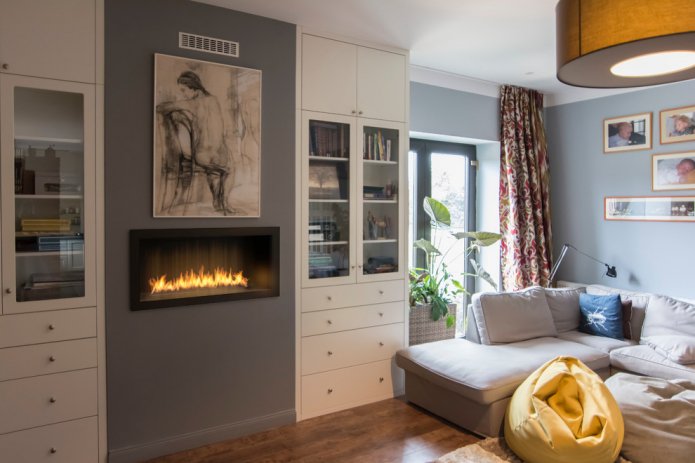
The photo shows the interior of a cozy living room in white and gray. A rectangular biofireplace built into the wall fills the room with warmth.
Built into furniture
A fireplace built into furniture takes up little space, but creates a feeling of coziness in the interior. A mini biofireplace can be built into a coffee table. As a rule, it is installed on a flat horizontal surface. The table is easy to move and will give a unique look to the interior. Another design option is a fireplace built into a tabletop or the central part of a cabinet.
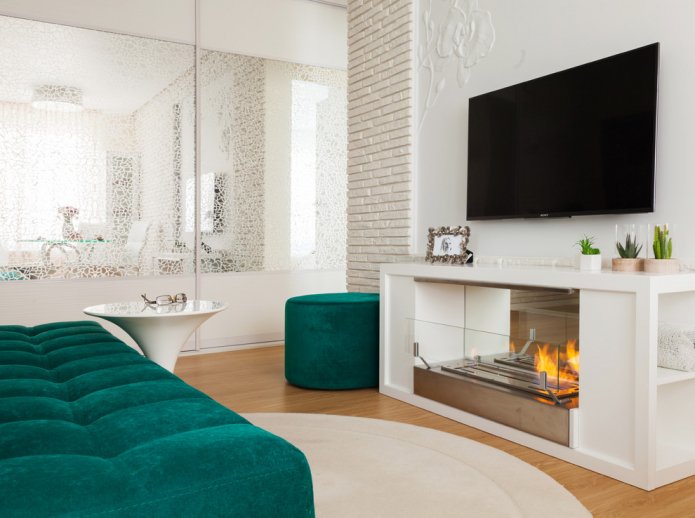
The photo shows the interior of a bright living room in a modern style. The bio-fireplace is built into a chest of drawers, the back wall of which is decorated with mirror inserts.
Wall-mounted
The narrow design does not take up much space and, depending on the design, will decorate the interior in a modern style. The hanging model is fixed to the wall with 2 screws.
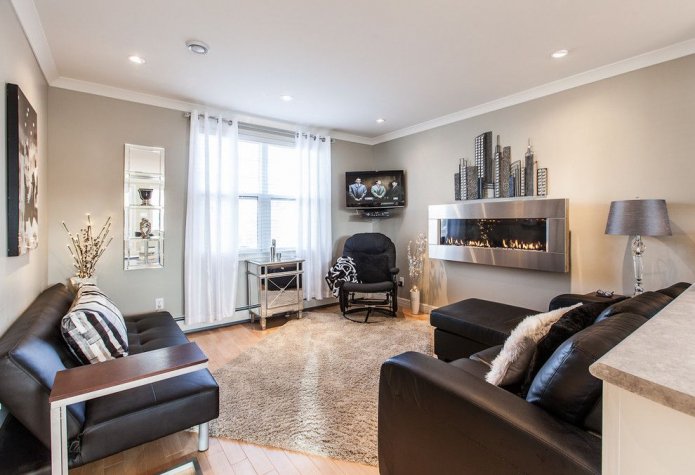
Floor-mounted
This type of bio-fireplace can be considered not a part of the interior design, but its main object. Unlike wall-mounted and built-in models, a floor-mounted bio-fireplace provides a full view of the hearth from any side. Floor models are heavier, but also portable.

Suspended
The bio-fireplace is attached to the ceiling. A similar model will look good in rooms with high ceilings and will decorate a modern interior.
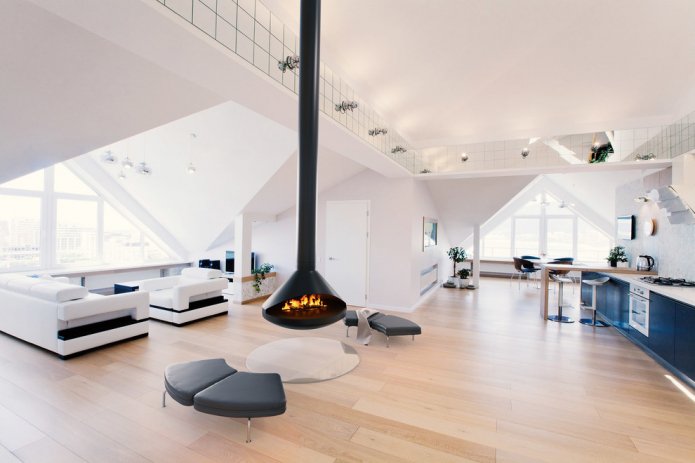
In the portal
The biofireplace in the portal imitates a fireplace in the classical sense. The portal itself can be made of various materials, and is of the wall type. The depth and width of the portal depend on the size of the fuel cartridge.
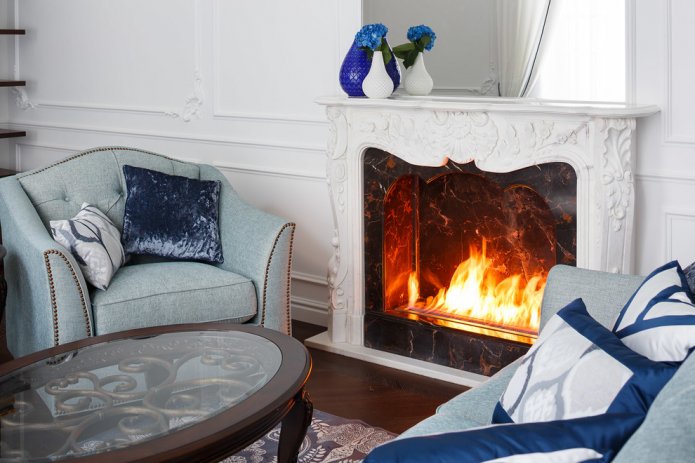
The photo shows an interior in a classic style. The bio-fireplace is “recessed” into the portal, and the body is made of stone and plaster.
Corner
The corner model can be installed in the corner of the room, thereby using the empty space. Another type of corner fireplaces is installed on the walls, so it can decorate two rooms at once.
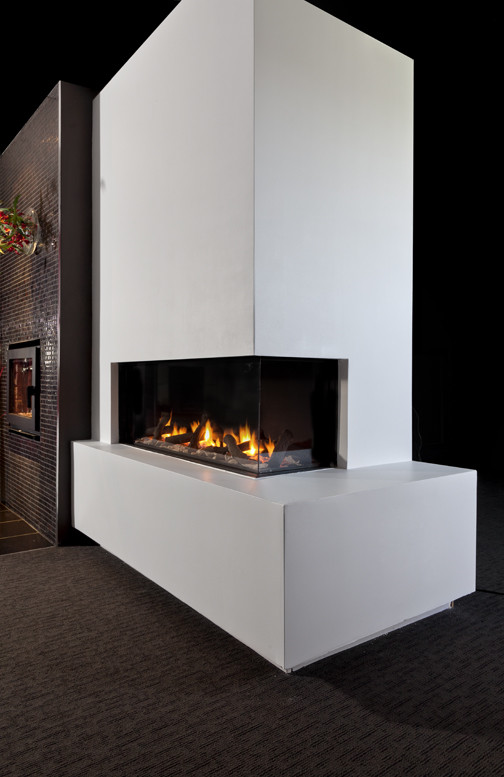
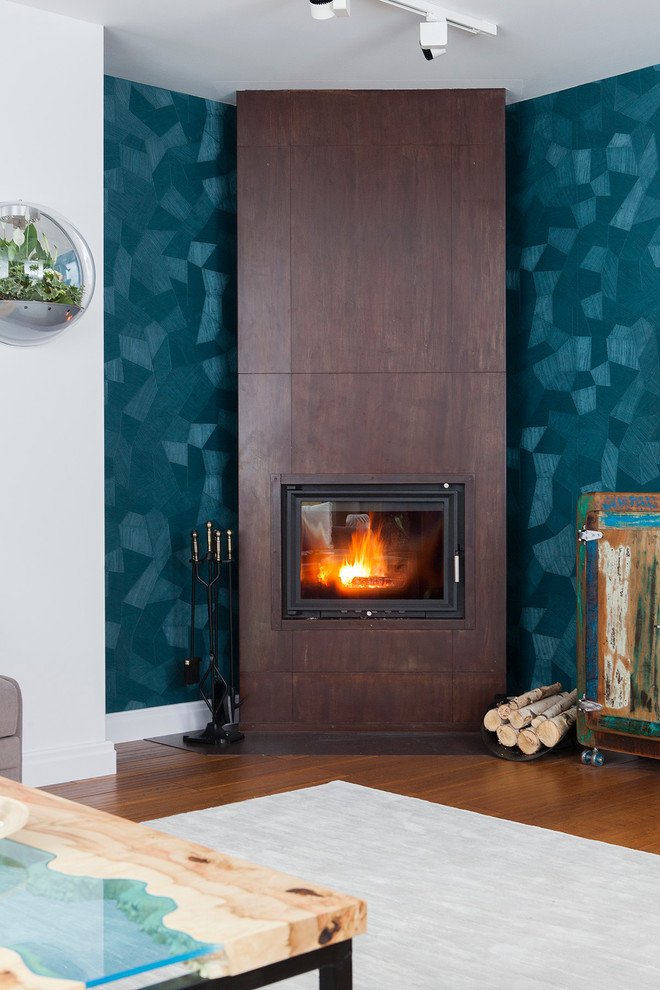
Round
A round or spherical bio-fireplace will suit a modern interior design. A round fireplace will look good as a suspended, floor or table model.

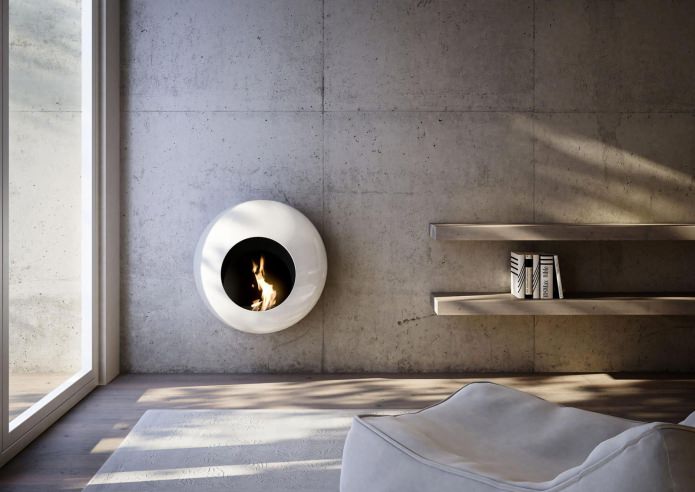
Materials, body design
Glass
A stylish design with glass will look harmonious in a modern interior. In addition, glass provides a full view of the flame. The body is made of reliable heat-resistant glass.

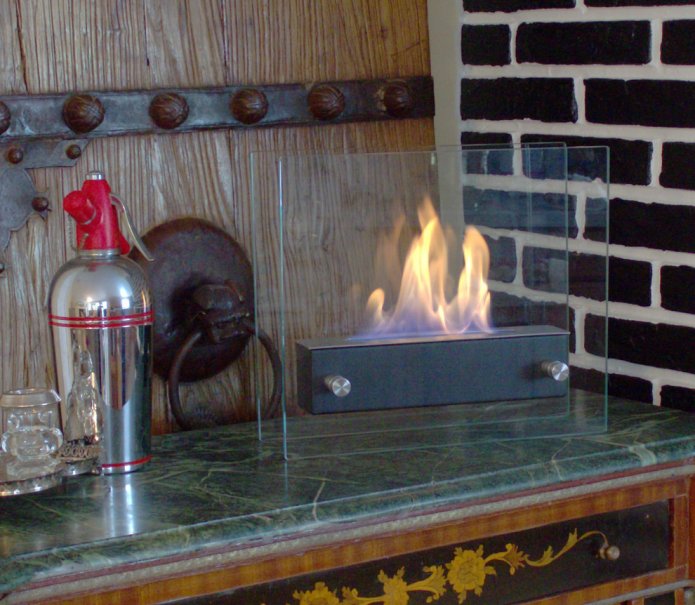
Ceramic body
This type is most often used in the manufacture of small structures, such as a tabletop bio-fireplace. Ceramics combine beautifully with flame. The body can also be decorated with ceramic tiles.
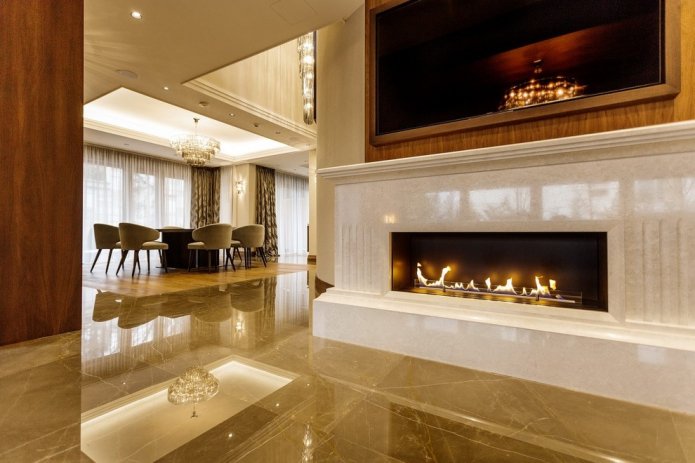
With a plasterboard portal
A plasterboard structure is a fairly economical way of decoration. The structure can be made independently or purchased ready-made. The size, shape and finish can be almost anything.
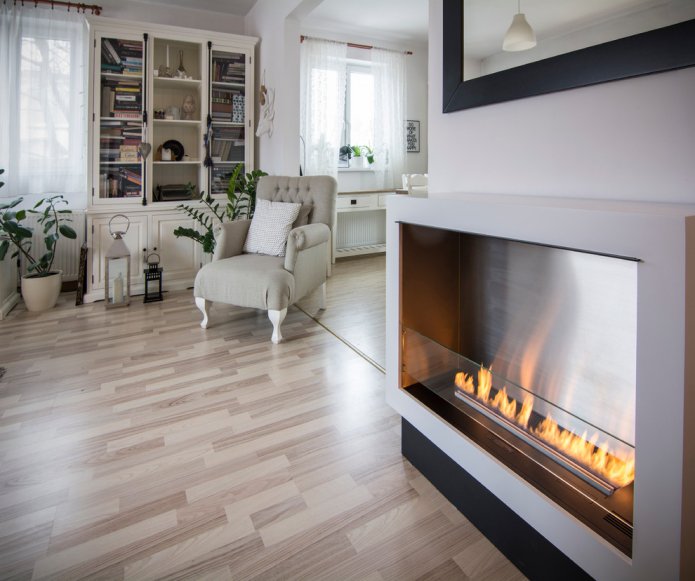
Marble body
A bio fireplace in a marble body is a luxurious and expensive piece of furniture. Natural marble or high-quality imitation will look perfect in any interior.

Wooden case
Wood is a beautiful and noble material. The design can be in classic, country or Provence style. The wood must be treated with a heat-resistant coating.
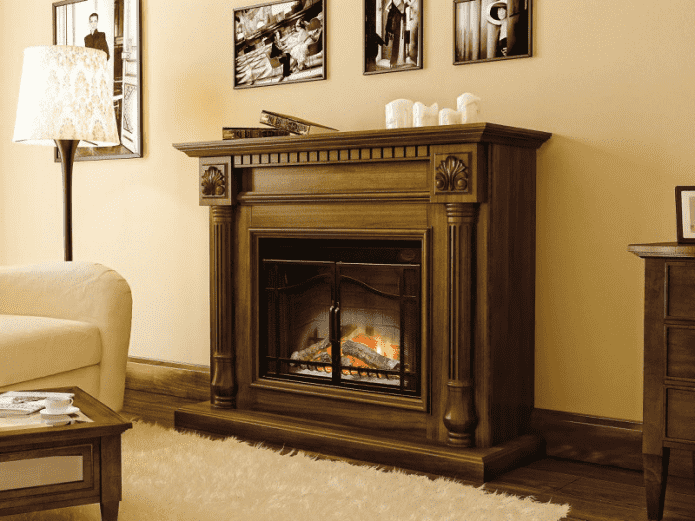
Accessories and decor
Accessories and decorative elements will add ambience and create the right atmosphere in the interior. It is worth remembering that the decor should not block the flame, but be located around the fuel block.
Ceramic firewood, burnt logs
Hot firewood or stones can be considered an integral part of the fireplace, they enchant with their warmth and mesmerizing color. For a bio fireplace, you will have to exclude natural wood. It will be replaced by ceramic products, which are almost indistinguishable in color and texture from real wood. Ceramic firewood can imitate any type of wood, most often it is pine or birch.
Imitation coals
Coals for a bio-fireplace are made of ceramics or glass ceramics. Visually, they are no different from real ones and exactly repeat the shape and color.
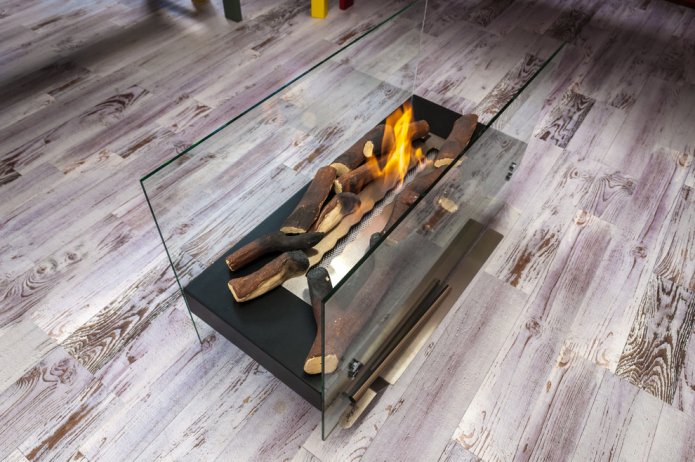
Stones, pebbles
Natural pebbles or stones are used. The material is strong and heat-resistant. For a more attractive appearance, the stones are polished and covered with the desired color. The fire is especially beautifully reflected on the varnished surface of the stone.
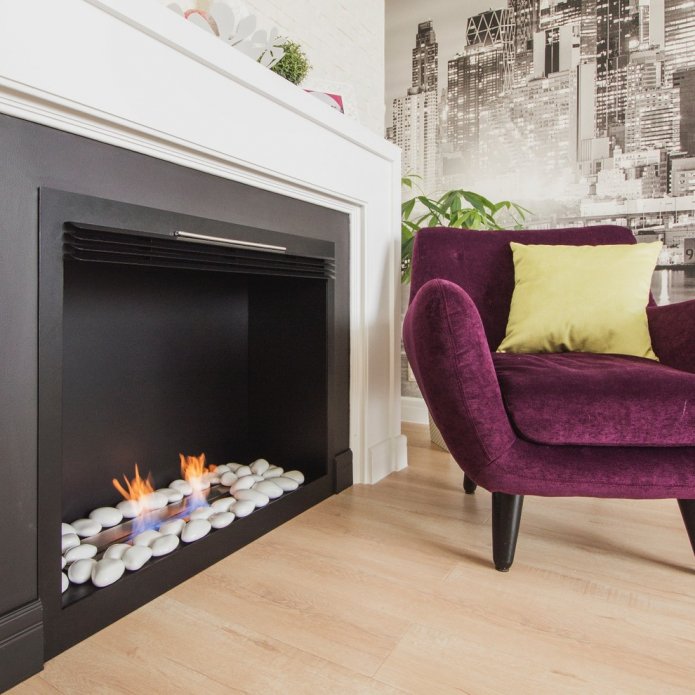
Photo in the interior of the apartment
Living room
A fireplace in the interior of the living room will envelop the room with a special coziness and fill an ordinary evening with charm. Different variations of location and design allow you to choose the ideal option for the interior of the living room. For example, a floor fireplace in a glass case for a modern style or in a portal with a marble frame for a classic one.
A big advantage of a bio-fireplace is the ability to use the space above the fireplace, for example, installing a TV above it. This design method is safe and looks impressive.
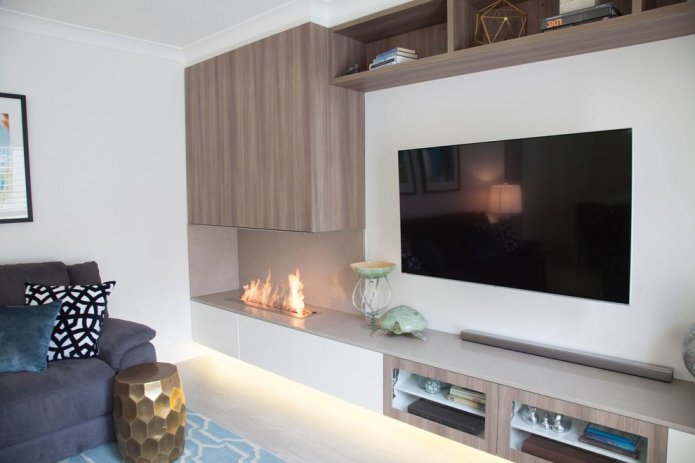
The photo shows a modern living room interior with a bio-fireplace built into the countertop.

Bedroom
Fire in the bedroom interior will help relax and give a romantic mood. For a spacious bedroom, you can use a built-in or floor fireplace. For a compact room, tabletop or built-in models are suitable.
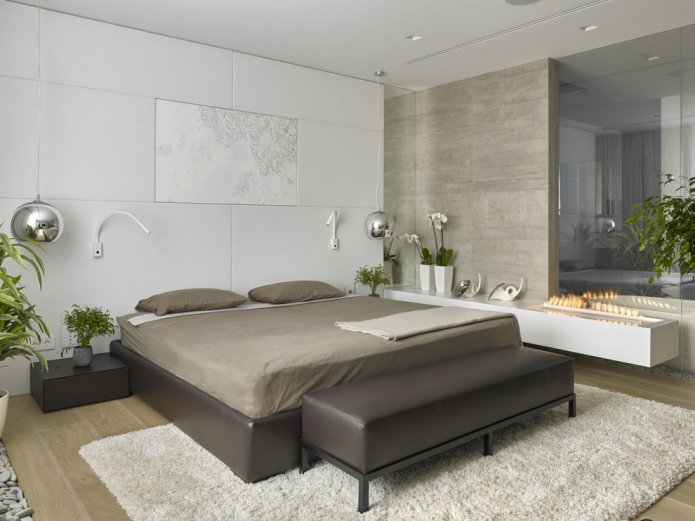
Kitchen
A fireplace in the kitchen interior is an unusual and original solution. It can be built into the wall, the end part of the island, or serve as a room divider. Another design option would be a small tabletop fireplace that would decorate the dining area.
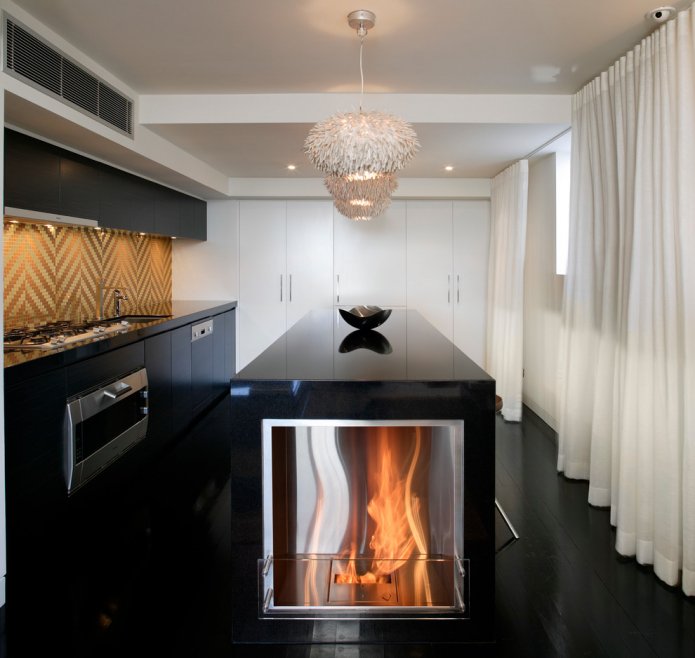
Loggia, balcony
A loggia or balcony will become a real lounge area even with a small bio-fireplace. The interior will be complemented by a table and a couple of cozy chairs. It is pleasant to finish the day under the warm glow of the fire on such a loggia.
Photo in a country house
A country house or a summer house is an ideal place for a fireplace. A large area allows you to choose unusual and voluminous models, while eliminating unnecessary hassle with kindling and maintenance.
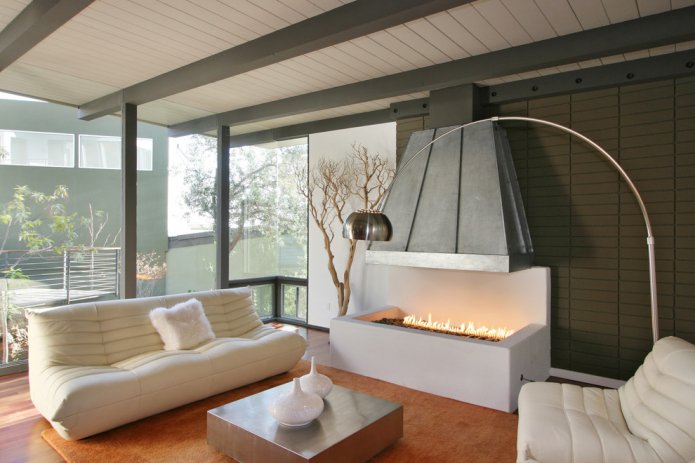
The photo shows a cozy lounge area of a country house. The bio-fireplace imitates a wood-burning one.
An original solution would also be to install a fireplace outside; a couple of armchairs opposite it and a cozy blanket will make an evening in the fresh air truly magical.
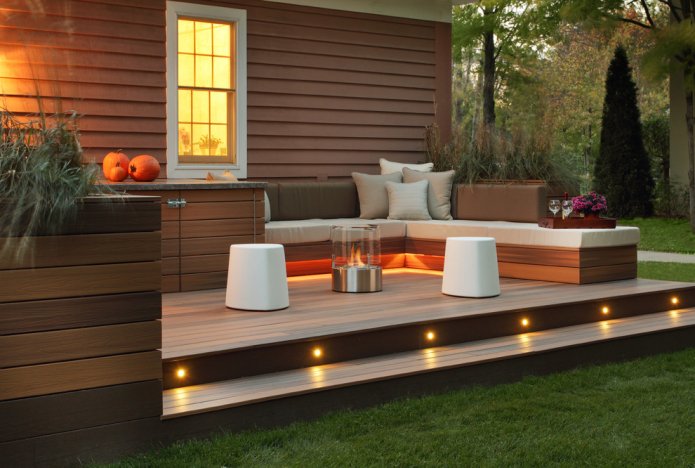
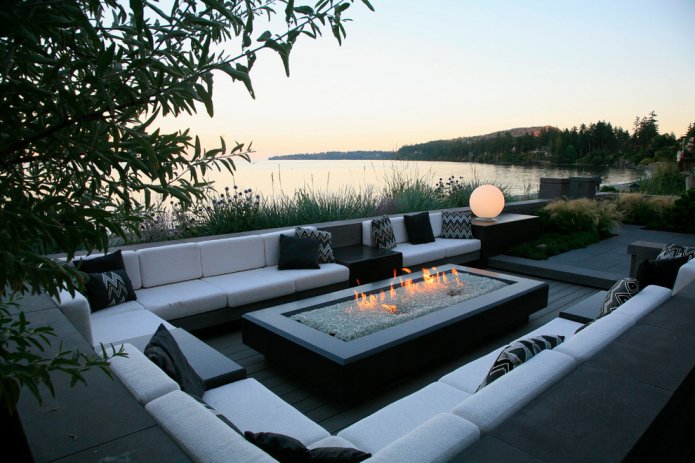
Presentation in various styles
Classic
The interior will be decorated with a bio-fireplace in a portal with a frame made of marble or plasterboard. Symmetrical shapes and straight lines will support the design concept.
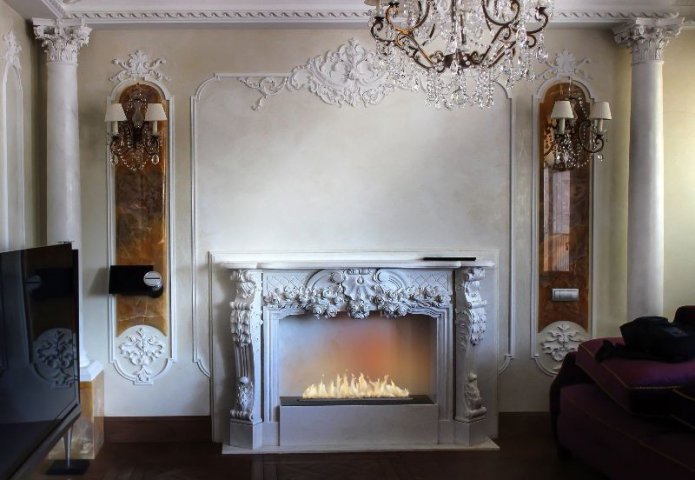
Modern
There are many design ideas for a modern interior. A bio-fireplace will be a great solution for such styles as minimalism or high-tech. A transparent glass, chrome or ceramic body will emphasize the style features of the interior.
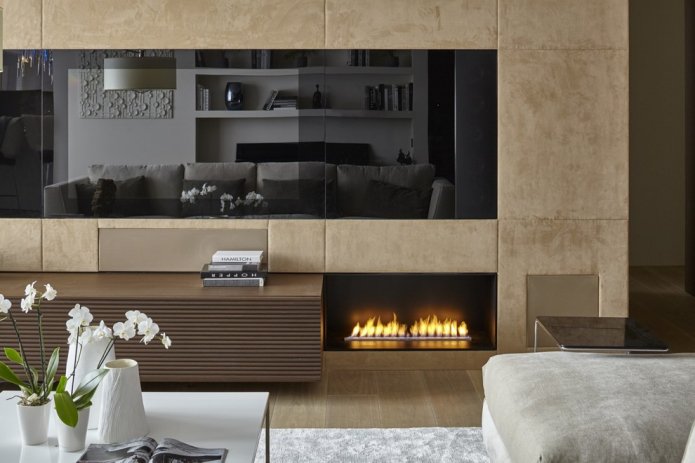
The photo shows a living room in a modern style, done in a warm palette. A small fireplace built into the wall decorates the interior.
Loft
The urban trend will be decorated with a biofireplace built into the wall or suspended. Fire will go well with cold, untreated concrete walls or brickwork.
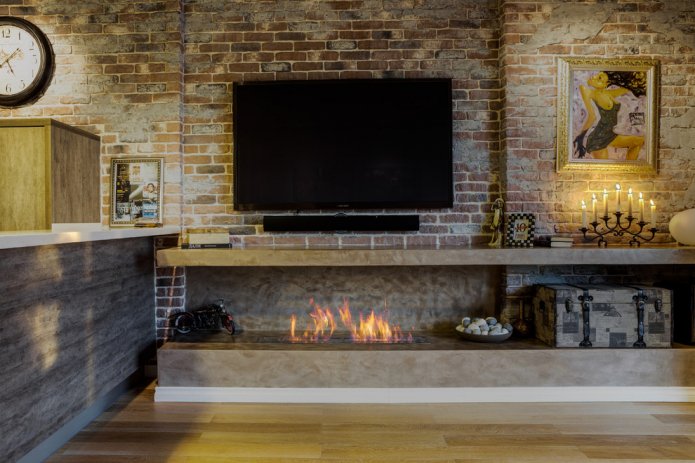
The photo shows a loft-style interior. A small fireplace is located under the TV and takes up a minimum of space.
Provence
Gentle and romantic Provence will envelop the room in warmth with a bio-fireplace in a wooden, stone or plasterboard frame. The interior will be complemented by ceramic firewood “under birch” and coals.
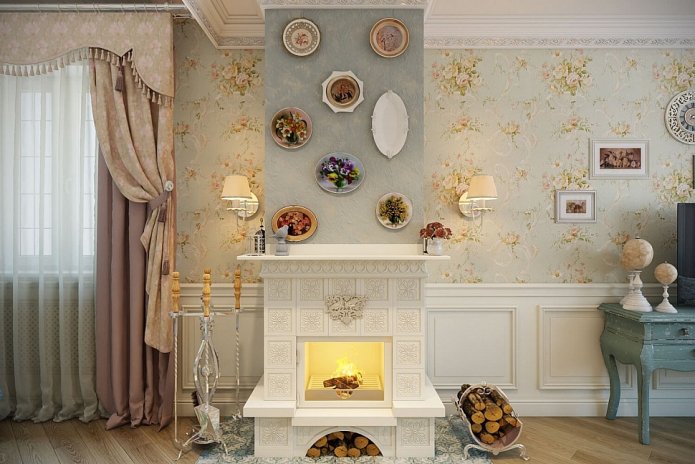
Now reading:
- Modern kitchens: 48 design ideas and photos for your interior.
- Mosaic of mirrors in the interior: ideas and photos for the kitchen, bathroom and other rooms.
- Exceptional Mercedes V-Class: Luxury Redefined
- Experience the Elegance of the Mercedes C-Class
- economical and practical ideas for paths between garden beds.